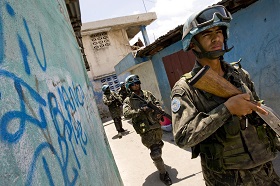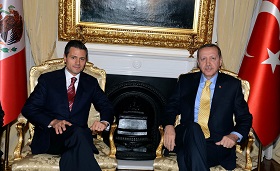The five states considered that under the current architecture of global governance they do not have a possibility to convey their own initiatives and proposals to the international community even within the G20, and, unlike the G7 and BRICS they do not have a mechanism for coordinating their approaches to global, especially, economic and financial issues. Late September 2013 on the sidelines of 68th session of the UN General Assembly the Ministers of Foreign Affairs of Mexico, Indonesia, South Korea, Turkey and Australia held a meeting during which they reached an understanding to form a new informal negotiating network of “middle powers” – MIKTA.
Late September 2013 on the sidelines of 68th session of the UN General Assembly the Ministers of Foreign Affairs of Mexico, Indonesia, South Korea, Turkey and Australia held a meeting during which they reached an understanding to form a new informal negotiating network of “middle powers” – MIKTA. The five states considered that under the current architecture of global governance they do not have a possibility to convey their own initiatives and proposals to the international community even within the G20, and, unlike the G7 and BRICS they do not have a mechanism for coordinating their approaches to global, especially, economic and financial issues. The first official meeting of MIKTA countries will be held in Mexico in 2014 when it is intended to adopt a Joint Declaration, currently under examination. Mexico will carry out organizational functions at that stage.
The unexpected emergence of a new acronym in the geopolitical dictionary gives rise to a lot of questions. Indeed after the forming of BRICS the analysts seemed to wage a contest for inventing new combinations of countries that could match BRICS in competition and be more attractive for investment in terms of economic growth prospects (Next 11, CIVETS, MINT, et al). However, it did not come to forming any new groupings. The most important question is – who stands to gain from the establishment of a new structure? Who came up with this exotic idea? What is the purpose of MIKTA? What are the prospects of this association’s sustainability and development? How cohesive it will be and what, presumably, would be its positions in the existing structure of global governance and in international institutions in general? Is its expansion possible? How will it interact with other associations within the “network diplomacy”?
Positions of MIKTA member-countries
Formally, the establishment of such a diverse community was initiated by South Korea. The term “middle power” in the diplomatic lexicon as a desirable status for that country emerged back in the 1990s. The international political science rates among this category about four dozens of countries – including some BRICS members – i.e. Brazil, India, and South Africa. The desire of South Korea to engage this political resource reflected the dissatisfaction of a rapidly growing economy and quite an ambitious nation with its somewhat “vassal” position in foreign politics. Indeed, South Korea, which is “squeezed” between major powers from its very inception fell hostage to an inter-systemic conflict and has been compelled for decades to follow in the wake of the U.S. policy. The term “middle power” that determines a particular place and a linking role of Korea between major powers and weaker states started to be increasingly used with coming to power of President Lee Myung-bak (2008). South Korea joined a number of specialized middle power groupings – such as Uniting for Consensus-Group – on the issue of UNSC reform, JACKSNNZ – on the issue of limitation of biological and toxin weapons, etc, and came up with the concepts of “green growth”, which were called upon to become benchmark targets for middle powers. The South Korean theorists believe that “middle power” diplomacy allows the country to break out of hostage situation in the U.S.-China confrontation and to use the advantages of network diplomacy and polycentric trends in the international relations.
Other countries, which initially were somewhat puzzled by the RoK initiative on a grouping based on their “middle” character, are now enthusiastically highlighting their relevance and emphasizing potential dividends from the viewpoint of national interests from participation in MIKTA. Even certain BRICS countries – for example, South Africa, show their interest in cooperation with the new association.
Territorially, the five states are distant apart from each other but they are quite close in terms of the level of economic development (according to the World Bank and IMF data Mexico was 11th, Republic of Korea – 12th, Indonesia – 15th, Turkey – 16th, and Australia – 18th in Gross Domestic Product 2012, purchasing power parity (PPP) ranking. These countries demonstrate solidarity on many issues such as the G20 functioning, the reform of the UN, climate change, and nuclear disarmament. The western commentators who are generally positive about the new grouping emphasize in particular the MIKTA countries’ commitment to democracy, market economy and their willingness to “contribute to the international community’s development”.
The Indonesian press emphasizes the role of the association as a “bridge builder” between the countries of different weight in the world arena. The Turkish official sources underline the countries’ “peaceful and constructive approach” to international issues and highlight their role in determining the status of post-2015 Millennium Development Goals. However, certain satisfaction is felt that Turkey, which “was not awarded” the EU membership, is now using MIKTA for pushing forward a multi-vector diplomacy. The experts take note of the fact that MIKTA comprises two major Muslim countries, whilst the Islamic states are practically unrepresented in the existing global governance structures. Mexico is satisfied that it has a possibility to readjust its image as a “pro-US” country and is seeking a more balanced representation among the rival centers of power, while its rapprochement with dynamically developing Asia-Pacific countries is of particular importance (Mexico is a member of Pacific Alliance that includes also Columbia, Peru and Chile).
Consequences for Global Agenda and Recommendations
The most important consequence of the emergence of MIKTA is the establishment of the “block of swing vote shareholders”, which depending on the situation may join the groupings of G7, developed countries or BRICS, which oppose each other on many issues, and decide the results of the vote in the framework of G20 in particular. This prospect is commented with some satisfaction in the West in the belief that it brings polyvariance in the decision-making process on the key issues of global agenda.
Judging by the composition and genesis of the group it will more often than not support the developed countries of the West (G7) during the vote on problem issues. Therefore, the emergence of MIKTA represents a challenge primarily for BRICS since it can substantially change the correlation of forces in the global governance architecture.
Moreover, some countries that earlier aspired for BRICS – such as Indonesia, Turkey, Mexico – have now turned to be linked with MIKTA. This of course does not prevent their subsequent admission to BRICS in the future but lowers the authority of this more powerful association. This is all the more the reason why BRICS should more promptly begin to consider the ideas on this association’s expansion. Drafting of decisions on this account should start already now for the BRICS Summit in Brazil scheduled for spring next year. The first in the line as it seems to me is Indonesia, not at least as representative of Muslim civilization (since BRICS among other aspects is also an intercivilizational association). Obviously MIKTA cannot claim such a role even if one cannot exclude that other “middle states” might join it – from Argentina to Saudi Arabia. Such ideas are circulating in the expert community. Among other considerations it can be assumed that this will not bury for good the Nonaligned Movement, which lost much of its authority after the end of the Cold War.
Besides, it is precisely BRICS that needs to make initiative steps, of course after mutual consultations, in order to launch mutually beneficial partnership with the new association. Indeed this new association has something to learn from BRICS in terms of determining the agenda (they are mostly similar for the two groupings), and the experience of discussion and decision making on issues of common interest, as well as in terms of institutional development. It can even be a matter of establishing permanent interaction between the two associations – first in the form of partnership and later perhaps in more binding forms, including associate membership or even amalgamation.
It is also worth for BRICS to start thinking about its cooperation with other “middle powers” – members of G20. Perhaps, it should begin with consultations and discussions on potential options at the expert level. A relevant useful platform for this is provided by the BRICS Think Tank Council created during the BRICS Summit in Durban (RSA, March 2013), which has as its founder on the Russian side the National Committee for BRICS Studies. Bilateral consultations are also possible. Russia could take upon the role of initiator both in discussing that issue among the BRICS countries and launching a dialogue with MIKTA.







